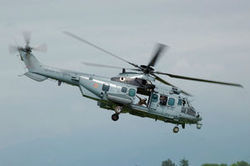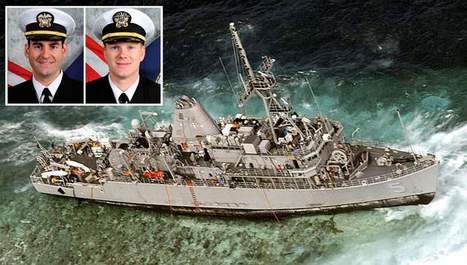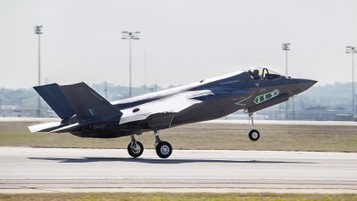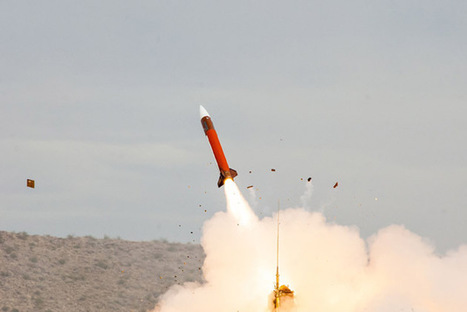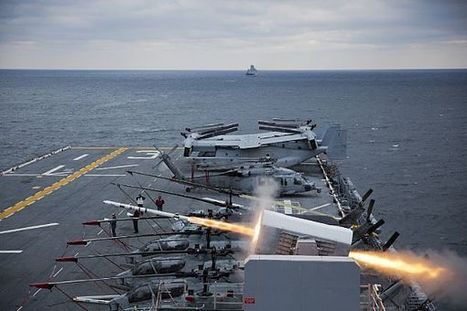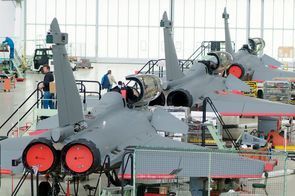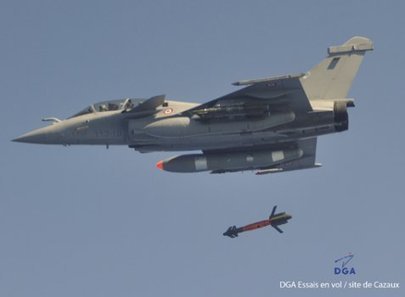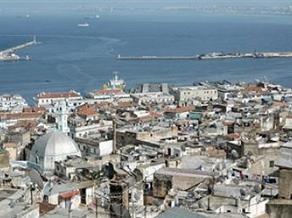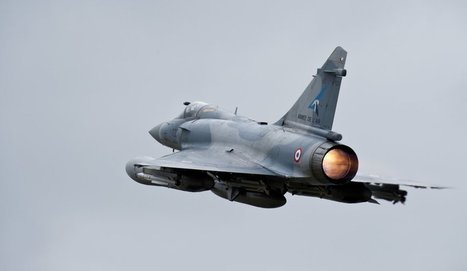 Your new post is loading...
 Your new post is loading...

|
Scooped by
Romain
April 5, 2013 8:36 AM
|
The US Department of Defense formally notified the US Congress of potential sales of the Boeing F-15SE Silent Eagle and Lockheed Martin F-35 Joint Strike Fighter to South Korea on 29 March. The two aircraft are on offer to the Asian nation as part of South Korea's F-X III fighter competition. The Eurofighter Typhoon is a third contender for the 60 aircraft tender. For the potential F-35 sale, the Defense Security Cooperation Agency (DSCA) says that South Korea could order 60 conventional A-model aircraft and associated support equipment for $10.8 billion. There would also be provisions for spares including nine additional Pratt & Whitney F135 afterburning turbofans. The package would also encompass training-including simulators. Lockheed Martin says that it is pleased that the formal Congressional notification process is now under way, but notes that the competing bids are still being evaluated by Korea and price discussions are "on-going".

|
Scooped by
Romain
April 5, 2013 8:34 AM
|
L'hélicoptériste européen, filiale d'EADS, annonce un partenariat avec le motoriste français Turbomeca pour la construction de deux lignes d'assemblage en Pologne en cas de victoire dans l'appel d'offres de la Pologne pour 70 appareils multirôles. En plus de ce partenariat, un accord de coopération industrielle a également été signé le 4 avril avec Wojskowe Zaklady Lotnicze (WZL 1), l'usine d'aviation polonaise basée à Lodz. Avec ce partenariat, Eurocopter souhaite mettre toutes les chances de son côté pour remporter l'appel d'offres lancé par la Pologne pour le renouvellement de 70 hélicoptères multi-rôles. "On est là pour gagner. C'est le plus grand appel d'offres d'hélicoptères en perspective en Europe", a martelé Olivier Lambert, vice-président d'Eurocopter en charge des ventes, lors de la signature de ce partenariat à Lodz. L'hélicoptériste de Marignane présente sa plus belle carte, l'EC725 Caracal. Un appareil qui a "démontré sa fiabilité et son efficacité sur de nombreux théâtres d’opération", soutient le VRP d'Eurocopter. Et il a sorti de sa botte l'appui de Turbomeca, filiale de Safran, qui fabrique les moteurs Makila 2 de ce bolide des airs capable d'atteindre 320 km/heure. "La stratégie de partenariat menée par Turbomeca repose sur le moteur Makila qui a fait ses preuves dans des environnements difficiles, et sur le savoir-faire que nous avons acquis dans le cadre de coopérations étroites", commente Maxime Faribault, directeur des ventes hélicoptéristes chez Turbomeca. En cas de victoire de cet appel d'offres, Eurocopter créerait donc une ligne sur le site de WZL 1 pour assembler ses EC725 et développer une activité de maintenance, quand Turbomeca en installerait une deuxième sur un autre site pour y assembler ses moteurs Makila et fournir l'hélicoptériste. Eurocopter parie gros avec cette opération. Face à ses concurrents sur l'appel d'offres, l'américain Sikorsky et l'anglo-italien AgustaWestland, grâce à cette annonce, il bombe le torse en mettant en avant sa position de leader mondial et la coopération à long terme avec l'industrie aéronautique polonaise.

|
Scooped by
Romain
April 5, 2013 5:23 AM
|
Le géant Américain des télécommunication militaires Harris Corporation vient de décrocher un important contrat en Algérie.
En effet Harris a décroché le contrat de fourniture d'un système de communication voix et données pour le contrôle aérien militaire Liberty Star VCCS.
ce système monté dans un shelter mobile, permettra à l'armée de l'air Algérienne de contrôler le trafic aérien même dans des endroits reculés du pays. Ce VCCS représente le septième équipement du genre en Algérie. Quatre autres systèmes VCCS sont en option.
Ce marché fait la part belle au transfert de technologie et de technicité car nous apprenons qu'il impliquera grandement des partenaires Algériens dépendant de la direction des fabrication militaires.
Le déploiement de ce système permettra une communication en temps réel avec les aéronefs, ainsi qu'un transfert de données en haut débit vers le sol et ce sur l'ensemble du territoire national.

|
Scooped by
Romain
April 5, 2013 5:15 AM
|
L'armée russe recevra le premier missile balistique intercontinental de 5e génération modernisé Iars-M d'ici la fin de l'année, a appris jeudi RIA Novosti d'une source au sein de l'industrie de défense russe. "Nous remettrons un missile balistique Iars-M au ministère russe de la Défense d'ici la fin de 2013. Le missile sera livré à l'armée la même année", a indiqué le responsable. Selon le général en retraite Victor Essine, ex-chef d'Etat-major général des Troupes balistiques stratégiques russes, le missile modernisé Iars-M est doté d'un meilleur système de commande que son prédécesseur. Deux divisions des forces nucléaires russes sont déjà équipées de missiles de 5e génération Iars et Topol-M. Trois autres divisions seront dotées de ces missiles en 2012, d'après le général Sergueï Karakaïev, commandant des Troupes balistiques stratégiques russes. Le RS-24 Iars (code OTAN SS-X-29), missile à propergol solide et à trois étages, est une version modernisée du missile monobloc RS-12M2 Topol-M. Il est doté d'ogives multiples de 150 à 300 kt à guidage individuel et a une portée de 11.000 km Le RS-24 constituera, avec le Topol-M monobloc (RS-12M2), le noyau des forces nucléaires russes. La puissance d'une ogive du missile Iars ou Topol-M (en équivalent TNT) est 50 fois supérieure à celle des bombes atomiques utilisées à Hiroshima et Nagasaki.

|
Scooped by
Romain
April 5, 2013 4:43 AM
|
Lockheed Martin has announced that its Havoc 8x8 Armored Modular Vehicle has successfully completed amphibious testing as part of its evaluation for the Marine Personnel Carrier (MPC) competition. The testing, conducted in and near the surf at the US Marine Corps Base Camp Pendleton, California, saw the Havoc undergo trials while loaded to its full combat weight. According to Lockheed Martin, the vehicle demonstrated its resistance to water penetration while accommodating a full complement of marine corps battle gear for the crew.
Scott Greene, vice president of Ground Vehicles for Lockheed Martin Missiles and Fire Control, said: ‘The Havoc 8x8 showed its ability to negotiate all surf and wave conditions required by the United States Marine Corps. The vehicle maintained 100 percent operational readiness throughout the test.’
Lockheed Martin is offering the Havoc 8x8 vehicle as part of a team that includes Patria Land Systems, and the vehicle is an evolution of the Patria 8x8 Armored Modular Vehicle. The multi-mission, expeditionary ground combat vehicle is configured to allow for a wide range of weapons, sensor and communications options to address evolving mission requirements. Employing the baseline architecture of the Patria vehicle, Havoc features advanced mobility and transportability, and can protect its crew against a variety of extreme threats. Teams led by BAE Systems, SAIC, and General Dynamics are also providing demonstration and study vehicles for this phase of the competition. The programme aims to develop a range of personnel carrier, command and recovery vehicles to meet the requirements of the US Marine Corps. The successful vehicle is expected to enter service in 2015.

|
Rescooped by
Romain
from Newsletter navale
April 4, 2013 9:50 AM
|
The Navy fired the former commanding officer of the now-stricken mine countermeasures ship Guardian along with three of his officers after an investigation determined they “did not adhere to standard U.S. Navy navigation procedures,” the Navy said Wednesday.Lt. Cmdr. Mark Rice, the ship's CO, was fired Wednesday by Rear Adm. Jeffrey Harley, the commander of Expeditionary Strike Group 7. The reliefs came while Rice and his crew were to take charge of the replacement ship, the minesweeper Warrior, which arrived last week in Sasebo, Japan.The reliefs included the second-in-command, Lt. Daniel Tyler, who also served as the navigator; the assistant navigator; and the officer standing watch as the officer of the deck at the time of the grounding. Officials declined to release the names of the other reprimanded junior officers, citing privacy laws.“All four sailors were relieved by Rear Adm. Jeffrey Harley due to their role in the grounding and a loss of confidence,” the Navy's press release said.They have been temporarily assigned to ESG-7 pending the completion of the investigation. The reliefs complicate the picture of the Jan. 17 grounding in the Philippines, which officials have so far blamed on an error on a digital chart that incorrectly plotted the Tubbataha Reef eight nautical miles from its actual location. Guardian ran hard aground and the crew of 79 was removed without injury. But the months-long saga, as Guardian's fiberglass and wood hull pounded furiously against the coral while experts attempted to extricate it, was covered for weeks in the press and angered locals because the damage occurred in a National Marine Park, which has been designated a World Heritage Site by the United Nations. The 7th Fleet commander, Vice Adm. Scott Swift, apologized four days after the incident. The minesweeper was decommissioned on March 6 in Sasebo, Japan. Navy divers finished sawing through the hull and craning the cut-apart hull off the reef on March 29.
Via Patrick H.

|
Scooped by
Romain
April 4, 2013 8:54 AM
|
Entre cinq et sept missiles intercepteurs américains GBI sont nécessaires pour intercepter un missile balistique russe Topol-M, a déclaré aux journalistes mardi l'ex-commandant en chef des Troupes russes de missiles stratégiques (RVSN) Viktor Essine. "De mes contacts avec le directeur de l'Agence de la défense antimissile, j'ai appris que les Américains auraient besoin d'entre cinq et sept antimissiles pour intercepter notre Topol-M", a fait savoir M.Essine lors d'une conférence de presse organisée à RIA Novosti. Pour le moment, les Etats-Unis ont déployé 30 missiles GBI, dont 26 sont implantés en Alaska et quatre autres en Californie, a poursuivi M.Essine. Toujours selon lui, les capacités des missiles intercepteurs US sont à l'heure actuelle "très limitées".

|
Scooped by
Romain
April 3, 2013 8:39 AM
|
Airbus Military and PT Dirgantara Indonesia (PTDI) have signed a comprehensive agreement for the development of the NC212i, an upgraded version of the C212 tactical transport. "Under the terms of the agreement, the companies will be long-term, risk-sharing partners with engineering and manufacturing being led by PTDI, supported by Airbus Military, and certification being an Airbus Military responsibility," says Airbus Military. "The aircraft will be delivered from Bandung in Indonesia and will be promoted and supported by PTDI and Airbus Military teams worldwide." The deal was signed at last week's Langkawi International Maritime & Aerospace Exhibition in Malaysia. The two companies first announced plans for the NC212i in November 2012. The aircraft will offer new digital avionics and a new autopilot. The civilian variant will have capacity for up to 28 passengers, compared with 25 for the C212. Airbus Military forecasts a market for 400-450 aircraft of this size in the next decade.

|
Scooped by
Romain
April 3, 2013 7:12 AM
|
Boeing et les techniciens de l’USAF ont procédé le 20 février 2013, à St Louis, au premier vol de l’avion de combat F-15SA (Saoudi Advanced). La nouvelle est presque passée inaperçue, et pourtant elle est de taille. Sur le papier, le F-15SA est le meilleur F-15 jamais produit et livré dans le monde. Il intègre, sur une cellule biplace, nombre d’innovations dévoilées par Boeing sur le F-15SE (Silent Eagle) lors du dernier salon de Singapour, début 2012. C’est ainsi que les commandes vol classiques cèdent la place à des commandes de vol électriques, une révolution technologique sur ce vétéran. Exit aussi le système d’arme dont l’architecture, révolutionnaire à sa sortie, est aujourd’hui totalement dépassée. La nouvelle architecture retenue table sur des bus de données reliant un nouveau radar à antenne active, un nouvel ensemble d’autoprotection, entièrement numérique, et la capacité d’intégrer tous les derniers armements air-air et air-sol et des nacelles de désignation « made in USA ». Autant de nouveautés qui s’ajoutent à la faculté d’utiliser la liaison 16, cette liaison tactique protégée, qui confère à son porteur une parfaite intéropérabilité avec l’OTAN. Les pilotes de F-15SA seront équipés de viseurs de casque. Ainsi dotés, ils pourront désigner leurs cibles dans un domaine beaucoup plus étendu, sans pour autant perdre de vues les principaux paramètres de vol. Naturellement le cockpit a été revisité. Désormais toutes les données sont affichées sur des écrans multifonctions largement dimensionnés, compatibles avec l’emploi de systèmes de vision nocturne. Pour Boeing, ce contrat permet tout simplement de garder les chaines de production du F-15 ouvertes pour quelques années encore tout en se faisant financer les études technologiques liées au programme F-15SE. Une évolution technologique de ce vétéran de la guerre froide, invaincu en combat aérien qui plus est, et qui pourrait représenter une alternative crédible à un JSF hors de prix. Au-delà de son montant record, 30 milliards, ce contrat est symbolique à plus d’un titre. Il illustre d’abord la volonté des avionneurs américains d’aller chercher à l’export les commandes qu’ils n’ont plus en Amérique. Une politique menée avec la bénédiction des autorités américaines qui assouplissent les règles d’exportation de technologies militaires « ITAR ». Il illustre aussi un virage dans la politique américaine qui consent, pour la première fois, à livrer à un pays arabe, un appareil supérieur à son équivalent israélien. Un déséquilibre qui devrait peut être se combler avec la livraison de F-35 dans quelques années.

|
Scooped by
Romain
April 3, 2013 6:48 AM
|
Monday, the third United Kingdom Lockheed Martin F-35 Lightning II
sped down the runway at Naval Air Station Fort Worth Joint Reserve Base
embarking on its first flight. The aircraft, known as ZM137, departed at 10:16
a.m. with Lockheed Martin F-35 Chief Test Pilot Alan Norman at the controls.
ZM137 will complete a series of company and government checkout flights prior to
its acceptance by the U.K. Ministry of Defence. ZM137 will join U.K. aircraft
ZM135 and ZM136 at Eglin Air Force Base, Fla., later this year where it will be
used for pilot and maintainer training.

|
Scooped by
Romain
April 3, 2013 6:25 AM
|
EADS change de peau. Une semaine après l’entrée en vigueur de sa nouvelle gouvernance, le groupe a officiellement mis en place sa nouvelle organisation, incluant la création d’un siège opérationnel unique à Toulouse dès le 1er avril. Ce nouveau siège sera totalement opérationnel à compter du 1er septembre 2013. Dans le cadre de cette réorganisation, un total de 116 postes actuellement basés à Paris et 75 à Munich seront transférés à Toulouse. A terme, plus de 500 postes dont les fonctions intégrées d’EADS, les directions ressources humaines et finance d’Airbus, une partie des services partagés, ainsi que d’autres fonctions clés de direction seront basés de façon permanente à Toulouse. Environ 250 postes de service et de support à Paris seront conservés, et le siège de Munich va garder 300 postes également. Cette installation en un siège unique est la dernière étape de la réorganisation entamée par l’accord, le 5 décembre dernier, du nouveau pacte d’actionnaire. L’influence des Etats n’y est plus que de 28% alors que les actionnaires historiques Lagardère et Daimler sont en train de se désengager définitivement du capital.

|
Scooped by
Romain
April 3, 2013 5:49 AM
|
Raytheon has received US Army approval for a second recertification which will see the operational life of the worldwide inventory of the Patriot missile extended from 30 to 45 years. This extension will allow customers to recertify and/or upgrade their inventory of Patriot missiles at a fraction of the cost of replacing them with alternative interceptors. The underlying technology and operational capability of the Patriot missiles have been continually enhanced throughout its operational life to counter high-speed tactical ballistic missiles and air breathing threats.
Patriot missiles are critical components of the Patriot Air and Missile Defense System. The system provides protection against a full range of advanced threats, including aircraft, tactical ballistic missiles, cruise missiles and unmanned aerial vehicles.
Sanjay Kapoor, vice president, Integrated Air and Missile Defense, Raytheon's Integrated Defense Systems, said: ‘This is a testament to Patriot's capabilities and combat performance that continue to exceed all expectations, now and over its successful operational life. This significant life extension decision by the army comes on the heels of a recent $46.7 million US Army contract awarded to Raytheon to recertify and upgrade Patriot missiles to the latest GEM-T configuration as part of the continuous Patriot modernisation effort.’

|
Rescooped by
Romain
from Newsletter navale
April 3, 2013 4:09 AM
|
The German Navy has awarded a contract to Raytheon to develop and deliver Block 2 Rolling Airframe Missiles (RAM), in a bid to boost its fleet self-defence capability. Under the single $155.6m contract, the company will supply RAM Block 2 missiles for the navy to better defend against threats. Raytheon Missile Systems president Dr Taylor W Lawrence said that the missile sale represented 35 years of testing achievements and capability improvements. "It complements the $100m RAM Block 2 production contracts with the US Navy signed in 2012 and follows our company's 11 critical Block 2 development test flights," Lawrence added. An upgrade of its predecessor, RAM Block 2 is a supersonic, lightweight, quick-reaction missile. Co-developed and co-produced by the US and Germany under the international cooperative programme, the RAM guided-missile weapon system can strike against anti-ship cruise missiles, helicopter and airborne threats, as well as hostile surface craft. Updates to the RAM Block 2 involve a four-axis independent control actuator system, passive radio frequency seeker, a digital autopilot and engineering changes in selected infrared seeker components. The guided-missile weapon system features autonomous dual-mode, passive radio frequency and infrared guidance design to provide high-firepower capabilities to combat multiple threats simultaneously. To date, the airframe missile has undergone more than 300 flight tests, resulting in a success rate of 95%. RAM is scheduled to undergo government testing in May. Currently, the RAM missile is deployed as an integral self-defence weapon onboard more than 100 ships for the navies of Egypt, Germany, Greece, South Korea, Turkey, the UAE and the US. Production work under the recent contract will be shared between both companies.
Via Patrick H.
|

|
Scooped by
Romain
April 5, 2013 8:35 AM
|
Delivering the first A-29 Super Tucano to the US Air Force in less than a year will be challenging but within Embraer's capability, says the president of the company's US subsidiary. "It's going to be a challenge obviously to maintain that schedule," says Gary Spulak, president of Fort Lauderdale-based Embraer Aircraft Holding. The terms of the light air support (LAS) contract require Embraer and prime contractor Sierra Nevada to deliver the first A-29 in the first quarter of 2014. In the meantime, Embraer must stand-up a final assembly plant in Jacksonville, Florida, hire and train about 50 workers and delivery the fully-assembled and weaponised light attack fighter. Spulak, however, notes that Embraer faced a similar challenge when it created a second final assembly plant for the Phenom-series light business jets in Melbourne, Florida, complimenting an existing assembly line at the Brazilian company's headquarters in Sao Jose Dos Campos, Sao Paulo. Embraer completed construction of the Melbourne plant in February 2011, and delivered the first US-assembled Phenom 100 less than a year later in December. Production output increased to 20 aircraft in 2012, and is expected to reach 32 this year and nearly 60 in 2014. The Super Tucano assembly process is modeled on the Phenom experience, with joined fuselage structures shipped to Jacksonville and assembled with tail, wings, landing gear and aircraft systems in the USA. "It is just as substantial a process as what you see there in Melbourne," Spulak says. "In terms of the delivery, by coincidence, that is also identical. So we're very, very comfortable with the lead time that we have."

|
Scooped by
Romain
April 5, 2013 8:28 AM
|
Selon la presse indienne, les négociations entre Dassault et l'Inde sur la vente à l'armée de 126 avions de combat Rafale achoppent sur un différend lié à la responsabilité du groupe français pour les 108 appareils devant être assemblés en Inde. Selon les termes du contrat évalué à 12 milliards de dollars entre Dassault et l'Inde, 108 des 126 Rafale commandés seront produits localement. Or, selon The Indian Express, les négociations achoppent actuellement sur un différend lié à la responsabilité du groupe français. Selon le journal, qui cite des sources anonymes, Dassault refuse toute responsabilité pour les 108 appareils assemblés par Hindustan Aeronautics Limited (HAL), le conglomérat d'entreprises publiques qui sera chargé d'assembler les avions de combats en Inde. Dassault a indiqué aux autorités indiennes que New Delhi devrait négocier deux contrats, l'un avec Dassault pour les 18 premiers appareils, l'autre avec HAL pour les autres Rafale, poursuit The Indian Express. Mais le ministère de la Défense aurait "totalement rejeté cette suggestion et a clairement dit à Dassault qu'il serait le seul responsable de la vente et de la livraison de l'ensemble des 126 appareils". Le groupe français, qui n'a à ce jour jamais vendu le Rafale à l'export, est entré en janvier 2012 en négociations exclusives avec le gouvernement indien, aux dépens de l'Eurofighter Typhoon, une coproduction de BAE, EADS et de l'italien Finmecanicca. L'appel d'offres avait été lancé en 2007. Le PDG de Dassault, Eric Trappier, espèrait une signature cet été mais les blocages dans les négociations pourraient se traduire par un nouveau retard.

|
Scooped by
Romain
April 5, 2013 5:16 AM
|
Brazil’s ambition to build a modern Navy with regional and sometimes global reach took a big step forward in February, when President Dilma Rousseff inaugurated a submarine-building facility that could eventually construct a fleet of nuclear-powered boats. Rousseff’s presence at the Itaguai facility at the Brazilian Navy’s base on Sepetiba Bay near Rio de Janeiro was the culmination of a near three-year building program undertaken by local company Odebrecht and its joint venture partner, France-based DCNS, to provide the industrial capability to deliver four of the French company’s conventionally powered Scorpene submarines. The potential for new naval business in Brazil, and elsewhere in Latin America, lies behind the attendance of a large number of maritime companies at the upcoming LAAD Defense and Security show due to kick off in Rio on April 9. Companies from Britain, China, France, Germany, the Netherlands, Spain, the U.S. and elsewhere are among the list of international naval suppliers with a presence at the show. All of them will be looking for signs as to whether Brazil’s slowing economy and high spending requirements to fund upcoming international sporting events such as the World Cup and the Olympics will affect the scope and timing of naval update plans. The Brazilian Navy already operates submarines, but the new unit at Sepetiba Bay is the first time local industry has had a facility to build its own boats. Besides being home to a submarine construction yard, plans call for the Sepetiba Bay facility to house a submarine base able to accommodate and support up to 10 vessels. Aside from the four diesel-electric boats, the submarine deal agreed to by the French and Brazilian governments in 2008 includes DCNS assistance in the design and production of a nuclear-powered submarine — although the Brazilians alone would be responsible for the reactor. DCNS is building the forward section of the first Scorpene submarine at its Cherbourg plant in northern France and shipping it over to Itaguai, a company spokeswoman said. The remainder of the program will be undertaken in country as part of Brazilian moves to build local industrial capabilities across the defense sector. The first of four submarines in the PROSUB program is due for delivery in 2017, the second in 2018, third in 2020 and fourth in 2021, she said. The first nuclear-powered submarine is due in 2025, adding Brazil’s name to an exclusive club with the capability: Britain, China, France, India, Russia and the U.S. Some European executives, though, are concerned whether Brazil, even with non-nuclear assistance from an experienced submarine builder such as DCNS, can meet the in-service target date for the nuclear-propelled attack craft. Worse than that, they say, the program could divert funds from other weapons programs if it is hit by serious budget overruns. Beefing up their submarine capabilities isn’t the only naval update the Brazilians are eyeing. Offshore patrol vessels (OPVs), frigates, an aircraft carrier, inshore patrol craft and eventually logistics support vessels will all likely figure in an update of a surface fleet, which will look pretty tired by 2017, executives said. Last month saw the surface fleet expand with the handover of the second of three offshore patrol boats acquired from British shipbuilder BAE Systems. A contract with a local shipbuilder for a batch of inshore patrol craft could be awarded in the next few weeks, executives said. They add that the award could be followed this year by a consulting deal between Brazil and an overseas yard in what is likely to be the first step toward designing an aircraft carrier to replace the Sao Paulo, the ex-French carrier Clemenceau, by the middle of the next decade. BAE, Fincantieri, Navantia and others are vying to secure what would be a key deal ahead of Brazil moving toward design and construction. The Brazilians have begun updating other parts of the surface fleet with the 133 million pound ($201 million) purchase of three OPVs from BAE in January 2012. The agreement also includes a manufacturing license to allow for a further batch of vessels to be built locally — although there is no guarantee the Brazilians won’t look elsewhere to build up OPV numbers. The Brazilians have been talking to the British and other contenders about their frigate requirements, and have had engineers embedded for several months in the BAE-led team designing the Type 26 Global Combat Ship for the Royal Navy.

|
Scooped by
Romain
April 5, 2013 5:13 AM
|
L’armée de l’air sud-coréenne va équiper ses chasseurs F-15K de missiles européens Taurus à fort pouvoir de pénétration, a indiqué le ministre de la Défense devant une commission parlementaire, jeudi. Cette décision intervient dans un contexte de tension accrue dans la péninsule coréenne et alors que le régime communiste nord-coréen s’est récemment déclaré en état de guerre avec son voisin du sud. Ces missile sont fabriqués par Taurus Systems, un partenariat entre la filiale allemande d’EADS et le Suédois Saab Bofors Dynamics.

|
Scooped by
Romain
April 4, 2013 12:03 PM
|
Ce n'est plus qu'une question de jours. Après un ultime "coup de tampon" officiel attendu très prochainement, la version à guidage laser du kit de guidage AASM (Armement Air Sol Modulaire) de Sagem sera déclarée opérationnelle sur Rafale.
A l'origine prévue pour la fin de l'année, cette étape a été avancée afin de répondre à une "urgence opération" approuvée par l'Etat-major des armées. L'objectif étant de pouvoir doter les huit Rafale actuellement déployés à N'Djamena, au Tchad, d'une capacité de frappe sur cibles mobiles rapides (jusqu'à 80 km/h) au-dessus du Mali.
Pour mener à bien cette mise en service accélérée, les expérimentateurs du CEAM (Centre d'expériences aériennes militaires) ont été mobilisés, notamment l'équipe de marque Rafale et le Centre d'expertise de l'armement embarqué (CEAE) de Cazaux. Deux tirs d'expérimentation technico-opérationnelle ont été réalisés mi-février et mi-mars, le premier sur une cible fixe et le second sur cible mobile. Pour ce dernier essai, c'est un véhicule tout-terrain télécommandé qui servait d'objectif.
Cette première capacité opérationnelle sera toutefois circonscrite à un domaine d'emploi limité, et adapté au théâtre d'opérations malien. Pour exploiter toutes les capacités de la munition (frappe à longue distance avec illuminateur déporté, etc.), d'autres travaux d'expérimentation seront encore nécessaires.

|
Rescooped by
Romain
from Newsletter navale
April 4, 2013 9:49 AM
|
MOORESTOWN, N.J., April 3, 2013 – Lockheed Martin's Aegis Combat System recently completed a live fire test, using the system’s newest capability build, Baseline 9. During the at-sea test scenario, Aegis successfully detected, tracked and engaged a medium-altitude subsonic target from the USS Chancellorsville (CG 62). During the exercise, the USS Chancellorsville’s Aegis Weapon System sent tracking orders to the ship’s gun system by performing ballistic computations, providing pointing orders, readying ammunition and firing five-inch projectiles – all while striking the target high overhead with an SM-2 missile. “Every day our customers face a growing number of threats from our adversaries, which requires a continuous evolution in capabilities,” said Jim Sheridan, director of U.S. Navy Aegis programs for Lockheed Martin’s Mission Systems and Training business. “Baseline 9 as part of Aegis modernization ensures we stay one step ahead of each of those complex and sophisticated threats at a faster pace and with more technological advancements than ever before." Four additional live firing exercises will be completed aboard the USS Chancellorsville before the ship’s Combat System Ship Qualification Trial (CSSQT) events begin later this year. The ship is the first of four Aegis cruisers scheduled for Baseline 9 modernization. USS Normandy (CG 60), the next ship to receive upgrades, is nearing the end of the industrial phase of modernization and USS Princeton (CG 59) and USS Cape St. George (CG 71) are next in line to enter their availability periods.
Via Patrick H.

|
Scooped by
Romain
April 4, 2013 8:53 AM
|
En Algérie, trois navires militaires chinois, deux corvettes et un pétrolier ravitailleur ont accosté dans la baie d’Alger le mercredi 3 avril 2013. Selon l’armée algérienne, il s’agit de renforcer la coopération militaire entre Alger et Pékin, une coopération qui se développe peu à peu. Comme les relations diplomatiques, les relations militaires entre la Chine et l’Algérie sont réputées excellentes. Bien sûr, c’est Moscou qui est le premier fournisseur de matériel de l’armée nationale populaire. Mais, en 2007, la découverte de pièces défectueuses sur les avions russes livrés à l'Algérie avait provoqué une véritable crise entre les deux pays. L’Algérie avait restitué les avions et réclamé un dédommagement. Depuis, Alger diversifie ses fournisseurs et Pékin fait peu à peu son entrée. En 2006, le chef d’état major algérien s’était déplacé en Chine. Alger avait fini par commander des avions FC-1 Xiaolong pour pallier au retard des Russes. Le mois dernier, l’Algérie a commandé trois nouvelles corvettes. Si les navires militaires présents dans la baie d’Alger y sont dans le cadre d’une tournée internationale sur la lutte contre la piraterie, les deux corvettes présentes sont très similaires à celles commandées par Alger. Les experts de la marine algérienne ont prévu de tester certains équipements à bord des navires.

|
Scooped by
Romain
April 3, 2013 8:34 AM
|
Indonesia could obtain up to seven additional Airbus Military C295 tactical transport aircraft, which would bring its eventual total of the type to 16 examples. "The air force requires an additional seven aircraft," says Arie Wibowo, vice-president marketing and sales for PT Dirgantara Indonesia (PTDI). "Having 16 will allow them to form a full squadron." Jakarta entered a deal for nine C295s at the Singapore air show in February 2012. In addition to Jakarta's air force requirements, PTDI is promoting two C295s to the Indonesian National Police. The police would use them to transport special counter-terrorism teams. PTDI is also working with Airbus Military to promote the twin-engined turboprop to Malaysia and the Philippines. Jakarta has already received two completed aircraft (designated CN-295 in Indonesian service) from Airbus Military's Seville factory. The next five aircraft will be delivered in a green condition, with PTDI to customise the aircraft at a new Bandung delivery centre that it has set up for the programme. The last two aircraft of the original nine will be produced at a Bandung final assembly line, using kits sent from Airbus Military. The final assembly line would be used for the potential follow-on order for seven aircraft. Wibowo says PTDI also acts as a tier one supplier in the programme, producing the rear fuselage and the tail empennage.

|
Scooped by
Romain
April 3, 2013 6:49 AM
|
Defence and security company Saab has taken the strategic decision to find Swiss companies to develop, produce and assemble major components of the Gripen E aircraft, including the rear fuselage. More than 35 per cent of the work will be placed in the French- and Italian-speaking regions. This will create business volume for Swiss industry of approximately 200 MCHF and more than 500,000 man hours of work. The decision to grow the Gripen E supplier base in Switzerland is an important step for Saab’s Swiss Industrial Participation (SIP) programme. It demonstrates the company’s willingness and commitment to deliver major direct SIP packages for Gripen E and results from a continuous dialogue with armasuisse, Swissmem, GRPM (Groupe Romande Pour le Matérial de Défense et de Sécurité) and the Swiss Gripen Group (SGG for Direct Industrial Participation DIP).
The main areas of focus for the Swiss industry work will commence with the development, production and assembly of five major items; Gripen E rear fuselageGripen E pylons (weapon stations),Gripen E tail cone,Gripen E air brakes, and theGripen E external fuel “drop” tanks These initial packages represent over 500,000 man hours of work and business volume of 200 MCHF for Swiss industry, and is related to the 60 Gripen Es ordered by Sweden and 22 Gripen E fighters that may be ordered by Switzerland. Saab is looking for long-term partners to the Gripen program and will place more than 35 per cent of this business package in the French- and Italian-speaking regions. “We are currently in discussions with Swiss companies, including Small and Medium-sized Enterprises, throughout all regions of Switzerland that can be involved in this major project”, says Lennart Sindahl, Head of Business Area Aeronautics at Saab, and adds “We are looking for companies with advanced skills and strong competitiveness that can be our partners for the long-term and to quickly seal their involvement in the program.” Future potential of the Swiss involvement As a Gripen E supplier and partner, Swiss industry participation is not limited to the Swedish and potential Swiss aircraft, but includes future orders of Gripen E.
The Swiss partner companies will have full access to the technology involved in the work package. The transfer of knowledge will provide the companies with the skills and competence to compete for major orders from other aircraft manufacturers in the civil and defence sectors. Saab’s Swiss Industrial Participation Programme In line with armasuisse offset policy, Saab is committed to delivering a regional distribution of SIP, with 5 per cent in Italian-speaking, 30 per cent in French-speaking and 65 per cent in German-speaking Switzerland. Saab has a commitment to deliver SIP business valued at 100 per cent of the Gripen contract value. By the end of 2012, Saab and partners had delivered approximately 250 MCHF in business with more than 100 Swiss companies.

|
Scooped by
Romain
April 3, 2013 6:35 AM
|
Quelle-est la place de la France en Libye ? Après l’engagement de 2011, les déconvenues sont nombreuses alors que la France, et son allié principal le Royaume-Uni, n’ont visiblement pas su tirer partie de l’après-guerre. Les entreprises américaines, bien plus rodées à cet exercice, semblent bien tirer leur épingle du jeu, comme toujours. Mais qu’advient-il des questions de Défense ? Sensibles par nature, elles sont peu décrites dans la presse, si ce n’est lorsque l’on parle de Mirage. Les négociations se passent comme toujours dans l’ombre, mais les rumeurs vont bon train concernant la signature d’un accord autour de ce type d’appareils. Ainsi, des Mirage 2000-5 trouveraient preneur en Lybie. Ces avions pourraient être prélevés dans les forces françaises, mais aussi qataries. Ces derniers ont utilisé avec professionnalisme l’avion lors de l’engagement de 2011. Leur influence croissante dans cette partie du monde pourrait bien jouer en leur faveur. Ceci d’autant plus que des avions de chasse plus récents seraient dans leur intérêt. Reste aussi la possibilité de débloquer la situation aux Emirats. S’il n’est pas que question de la revente des 2000-9, ils sont vraisemblablement toujours proposés sur le marché de l’occasion. Des bases sous contrôle français en Libye ? En voila une idée qu’elle est bonne. Après l’ouverture de la base d’Al Dhafra, cela permettrait à la France de continuer sur sa lancée en ouvrant des bases plus proches de ses théâtres d’intérêt plutôt que sur le territoire national. Ainsi, il se raconte que deux à trois bases pourraient être construites sur le sol libyen. L’une d’entre elle pourrait d’ailleurs être positionnée au plus proche du Mali. En comparaison de N’Djamena, la situation n'en serait pas forcément avantageuse, ceci d’autant plus que l’Algérie se trouve en ligne directe. A voir donc si cela représente un réel intérêt ou non, mais la réflexion est lancée d’autant plus que si elle servirait à l’armée de l’air libyenne, elle serait sous contrôle français. Le Mirage 2000-5 a été mis en service en 1997, il s’agit de la dernière version du Mirage 2000. Il intègre d’ailleurs certaines fonctionnalités dérivées de celles du Rafale. Cette version a été commandée par la France (37 avions), la Grèce, le Qatar, Taiwan et les Emirats Arabes Unis dans une version différente désignée Mirage 2000-9. Les Mirage 2000-5F français furent engagés en Libye en 2011 aux côtés d’autres Mirage 2000D et 2000N. Ils survolèrent aussi les cieux libyens sous cocarde qatarie puisque six Mirage 2000-5 EDA furent engagés. A ceci doit être ajouté les six Mirage 2000-9 émiriens qui ont prêté main forte aux alliés en Libye. Ils furent d’ailleurs envoyés avec six F-16 C/D Block 60 auxquels ils furent comparés. Le RETEX est souvent donné comme favorable au Mirage alors que les F-16 ont connu deux accidents et n’ont pas pu remplir leurs missions. Des missions air-air et air-sol ont été effectuées.

|
Scooped by
Romain
April 3, 2013 6:11 AM
|
Les syndicats du fabricant de blindés et de canons Nexter, détenu à 100% par l'Etat craignent que ce dernier, contraint de dégager des ressources, cède des parts de leur entreprise, la CFDT évoquant même mardi une vente au Qatar. Nexter va-t-il être vendu au Qatar ? C'est en tout cas une piste pour la CFDT, qui relaie ainsi les craintes des syndicats du fabricant de blindés et de canons détenu à 100% par l'Etat. Dans un tract, elle dénonce en effet les "braves technocrates qui n'auraient pas d'état d'âme à vendre au plus offrant les bijoux de famille... Comme cela se susurre en coulisse, Nexter pourrait ainsi avoir pour repreneur le Qatar". "Il y a des rumeurs qui circulent. Il n'y a sans doute pas d'interdit pour un gouvernement de faire ça", a expliqué à l'AFP André Golliard, administrateur CFDT Nexter. Nexter, fabricant du char Leclerc, de véhicules de combat et de canons, a déjà été transformé en société anonyme. L'Etat en détient 100% des parts, afin de permettre une privatisation hypothétique. Un projet d'entrée de l'électronicien Thales au capital de Nexter est au point mort depuis près d'un an. Le Qatar, qui multiplie les investissements en France, pourrait donc s'imposer comme une solution pour l'Etat. "Risque d'éclatement du groupe" Selon Pierre Brat, délégué CFDT, le risque d'une cession à un investisseur étranger vient plus concrètement du groupe suédois Volvo, déjà propriétaire de Renault Trucks Defense, et qui est intéressé par les véhicules mais pas par la branche munitions de Nexter, "d'où le risque d'éclatement du groupe". La CFDT doit être reçue prochainement par des parlementaires pour discuter de l'avenir de l'armement terrestre en France.

|
Rescooped by
Romain
from Newsletter navale
April 3, 2013 4:09 AM
|
According to a Pentagon official, the US Navy deployed one of its Destroyers off the Korean Peninsula amid growing tensions with North Korea. USS Fitzgerald, who had sailed to South Korea recently to participate in joint military exercises, was sent to the south-west peninsula instead of returning to its home port in Japan, the official said, who wished to remained unnamed. This deployment is a cautious initiative that can offer "more options for missile defense if the need arises," the source added. USS Fitzgerald (DDG-62) is a is an Arleigh Burke-class (DDG-51) Flight I destroyer. It is capable to launch Raytheon's SM-3 missiles.
The SM-3 is a defensive weapon used by the U.S. Navy to destroy short- to intermediate-range ballistic missiles. The SM-3 destroys incoming ballistic missile threats by colliding with them, a concept sometimes described as “hitting a bullet with a bullet.” The impact is the equivalent of a 10-ton truck traveling at 600 mph.
DDG 51 multi-mission guided missile destroyers operate in support of carrier battle groups, surface action groups, amphibious groups and replenishment groups, providing a complete array of anti-submarine, anti-air and anti-surface capabilities. Designed for survivability, the ships incorporate all-steel construction and have gas turbine propulsion. The combination of the ships’ Aegis combat system, the vertical launching system, an advanced anti-submarine warfare system, two embarked SH-60 helicopters, advanced anti-aircraft missiles and Tomahawk anti-ship and land-attack missiles make the Arleigh Burke class one of the most powerful surface combatant ever put to sea.
Via Patrick H.
|



 Your new post is loading...
Your new post is loading...



